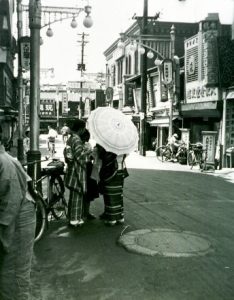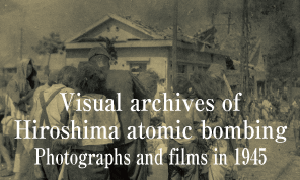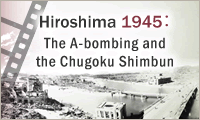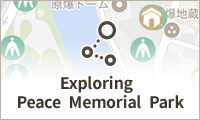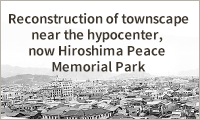Chugoku Shimbun survey finds 224 of 255 people in Nakajima-honmachi died on August 6; hypocenter now northern part of Peace Park
Jul. 13, 1999
On July 12, with the cooperation of bereaved families, the Chugoku Shimbun compiled information on the still-unknown damage to “Nakajima-honmachi,” the downtown area of Hiroshima annihilated by the atomic bomb on August 6, 1945. The site of the town has become the center of today’s Peace Memorial Park, which was developed under the Hiroshima Peace Memorial City Construction Law that took effect 50 years ago. A survey of the area between Aioi Bridge, the target of the atomic bombing, and former Nakajima Hondori Street, which ran east-west through the present-day peace park, revealed the circumstances of death for 255 residents and people working in the town due to the atomic bombing by the end of 1945. Of those, 224, or 88 percent, died that day.
We sought out those involved and traced the death of each resident using a list made by a group called Nakajima Peace Kannon Association, a group of former residents established in 1951 that conducts a memorial service for the A-bomb victims, by comparing it with publications and unpublished records, including a map of the hypocenter area created by the Research Institute for Nuclear Medicine and Biology of Hiroshima University in 1969.
Of the 260 people in 75 households confirmed to be living there on August 6, 207 people, or 80 percent, had died by the end of 1945. Seventeen people, who were heading to the mobilization site because of the country’s order from their place of refuge, or who owned stores in Nakajima-honmachi, had also died. In addition, the deaths of 23 workers at private businesses and at the Nakajima branch of the Hiroshima West Fire Station, which was newly discovered to be located at “18 Nakajima-honmachi,” were confirmed. Eight others, who were visiting relatives in the town at the time of the attack, also became victims.
About 120 bereaved family members cooperated with the survey. Many were children who had been evacuated to other places at the time, students who experienced the atomic bombing at mobilization sites around two kilometers from the hypocenter, women who experienced the A-bomb, with whom demobilized men remarried, and their children. The oldest was the 94-year-old woman who raised two orphans.
Many of those who lost their parents and siblings as children or students and had to live through the aftermath say: “I have not talked much about my experience, not even to my children, trying to forget about it.” One woman, who lost seven family members and was unable to obtain an Atomic Bomb Survivor’s Certificate, described how empty the area had become. “I returned to the site of my house to look for (my family), but I could not find anyone to prove it.”
Originating around the time Hiroshima Castle was built, Nakajima-honmachi was a bustling commercial and cultural center from the Meiji era until the atomic bomb was dropped. Military facilities, including Division No. 5 of the Japanese Imperial Army (which later became Chugoku District Military Headquarters), had also been built up on the north side of the Aioi Bridge.
Today, the site of Nakajima-honmachi is part of the Peace Memorial Park, with the Atomic Bomb Memorial Mound, which houses the remains of approximately 70,000 victims, located to the north of the former Nakajima Hondori Street and the Cenotaph for the A-bomb Victims located to the south. Construction of the Hiroshima National Peace Memorial Hall for the Atomic Bomb Victims will start this fall on a site adjacent to the former Tenjin-machi in accordance with the Atomic Bomb Survivors Relief Law. The memorial hall is scheduled to open in 2002.
(Originally published on July 13, 1999)
We sought out those involved and traced the death of each resident using a list made by a group called Nakajima Peace Kannon Association, a group of former residents established in 1951 that conducts a memorial service for the A-bomb victims, by comparing it with publications and unpublished records, including a map of the hypocenter area created by the Research Institute for Nuclear Medicine and Biology of Hiroshima University in 1969.
Of the 260 people in 75 households confirmed to be living there on August 6, 207 people, or 80 percent, had died by the end of 1945. Seventeen people, who were heading to the mobilization site because of the country’s order from their place of refuge, or who owned stores in Nakajima-honmachi, had also died. In addition, the deaths of 23 workers at private businesses and at the Nakajima branch of the Hiroshima West Fire Station, which was newly discovered to be located at “18 Nakajima-honmachi,” were confirmed. Eight others, who were visiting relatives in the town at the time of the attack, also became victims.
About 120 bereaved family members cooperated with the survey. Many were children who had been evacuated to other places at the time, students who experienced the atomic bombing at mobilization sites around two kilometers from the hypocenter, women who experienced the A-bomb, with whom demobilized men remarried, and their children. The oldest was the 94-year-old woman who raised two orphans.
Many of those who lost their parents and siblings as children or students and had to live through the aftermath say: “I have not talked much about my experience, not even to my children, trying to forget about it.” One woman, who lost seven family members and was unable to obtain an Atomic Bomb Survivor’s Certificate, described how empty the area had become. “I returned to the site of my house to look for (my family), but I could not find anyone to prove it.”
Originating around the time Hiroshima Castle was built, Nakajima-honmachi was a bustling commercial and cultural center from the Meiji era until the atomic bomb was dropped. Military facilities, including Division No. 5 of the Japanese Imperial Army (which later became Chugoku District Military Headquarters), had also been built up on the north side of the Aioi Bridge.
Today, the site of Nakajima-honmachi is part of the Peace Memorial Park, with the Atomic Bomb Memorial Mound, which houses the remains of approximately 70,000 victims, located to the north of the former Nakajima Hondori Street and the Cenotaph for the A-bomb Victims located to the south. Construction of the Hiroshima National Peace Memorial Hall for the Atomic Bomb Victims will start this fall on a site adjacent to the former Tenjin-machi in accordance with the Atomic Bomb Survivors Relief Law. The memorial hall is scheduled to open in 2002.
(Originally published on July 13, 1999)

